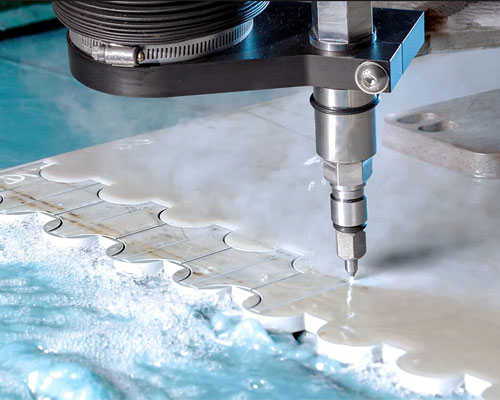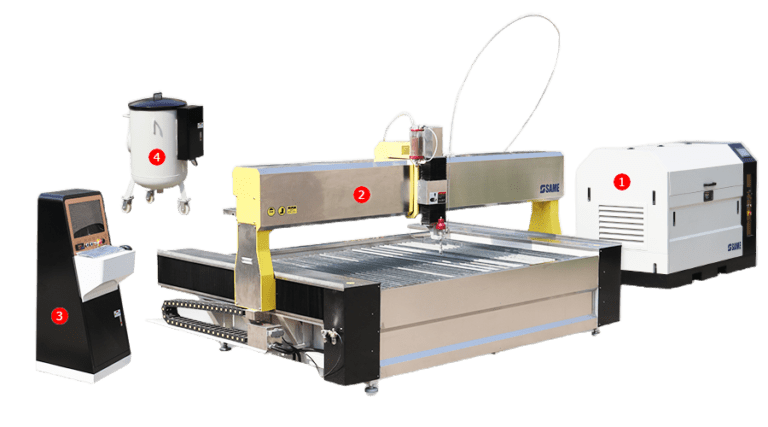What is Water Jet Cutting?
Learn. Explore. Decide.
WHAT IS A WATERJET CUTTER?
Waterjet cutting is simply an accelerated erosion process within a selected material. Highly pressurised water is fired through a ruby or diamond nozzle into a mixing chamber. This pressure creates a vacuum and draws garnet sand into the stream where it is then fired at the object in place for cutting.
The sand particles eat away at the material causing the effect of erosion to take place at such a high speed it is deemed as cutting.

Components of Waterjet Cutting Machine

1.The High-pressure pump
High-pressure pumps provide the water needed during
3.The Controller system
includes the programming software, operator interface, drive motors, and position and velocity feedback system
2.The Waterjet cutting platform
The cutting platform provides includes the X, Y, Z axes, cutting head wrist axes, and material support catcher
4.The Automatic sanding system
Automatic grinding and providing the particles needed for the cutting process
THE HISTORY OF WATERJET CUTTING
Dating back to the 1930s, waterjet were initially used as industrial cutting equipment, but only for soft materials such as paper.as researchers around the world looked for new ways to cut systems efficiently, waterjet technology developed in the postwar era.
In 1960, Dr. Norman Charles Franz pioneered the development of industrial waterjet cutting technology, creating the first industrial water knife to cut wood, the first waterjet used in industry, and has been running successfully for many years.
In 1979, Dr. Mohamed Hashish worked in a fluid research laboratory and began to study ways to increase the cutting energy of waterjet to cut metals and other hard materials. Dr Hashish is widely regarded as the father of the polished water knife. He invented a method of sanding a regular water sprayer. He uses garnets, a material often used on sandpaper, as a polishing material. With this method, the waterjet (which contains sand) can cut almost any material.
In 1983, the world’s first commercial sanding waterjet cutting system was introduced and used to cut automotive glass. The first users of the technology were the aerospace industry, who found the waterjet to be the ideal tool for cutting stainless steel, titanium and high-strength lightweight composites and carbon fiber composites used in military aircraft (now used in civil aircraft).
Since then, abrasive waterjets have been used in many other industries, such as processing plants, stone, ceramic tiles, glass, jet engines, construction, nuclear industry, shipyards, and more.
1930s
Invented low-pressure water jet for cutting paper
1960s
Waterjet can already be used to cut wood and metal
1979s
The water jet has been developed into a polished water jet, this method can cut almost any material
1983s
Water jets have demonstrated superior performance in various cutting fields
1997s
SAME Corporation established
RELATED QUESTIONS
Waterjet cutting is to accelerate the corrosion process in the material.
Highly pressurised water is fired through a ruby or diamond nozzle into a mixing chamber. This pressure creates a vacuum and draws garnet sand into the stream where it is then fired at the object in place for cutting.
The waterjet cutting system consists of a high-pressure water pump, a mobile nozzle and a cutting platform where the working material is placed. The control system is basically composed, and its composition can be fully expanded, upgraded and customized according to customer needs.
Grinding water jets can cut almost anything in the world, such as metal, stone, glass, etc., and many food processing companies use pure water cutting machines to cut food.
- No heat zones affect the material as it is cut with cold water
- Reduces the need for secondary operations due to its accuracy and smooth edge
- Safe cutting as the debris are caught in the waterbed. There are also no hazardous gases created and sent into the atmosphere.
- Cuts fragile material like glass and stone with ease
- Cuts plastic without showing signs of noxious fumes
- Has the ability to perforate most materials without starting holes
- Saves raw materials due to small cutting kerf width
- Cuts composite materials without any special treatment
- Minimal clamping force required to hold the work piece
- Can stack cut multiple thin sheets
- Can cut steel sheets with plastic protective sheet still in place

